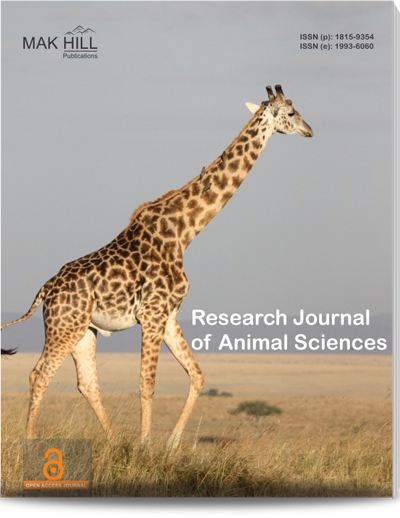
Research Journal of Animal Sciences
ISSN: Online 1994-4640ISSN: Print 1993-5269
Abstract
Using 10 camels, the post-slaughter activities and wholesale meat cut marketing at Kano municipal abattoir were studied. The major post-slaughter activities at the abattoir were flaying, evisceration and cutting, in that order. Camels were set in crouching position and flaying starts at position slightly over the hump. The wholesale meat cuts (as obtained at the abattoir) were neck-cut (mean weight = 15.93±1.00 kg), back-cut (mean weight = 32.43±4.85 kg), left (37.43±2.71 kg) and right (37.53±1.14 kg) forequarter, hindlegs (left = 27.00±0.65kg; right = 28.66±0.61kg), viscera (heart, 1.80±0.20kg; liver, 8.53±1.82kg; lungs, 3.45±0.11kg; full large and small intestines 30.50±2.17; caecum, 15.03±1.65kg ) and hide (mean wet weight = 43±3.67kg). The mean live weight of camels used in the study was 388.97±52.51 kg and costs 40, 000:00 to 60, 000:00 aira. The 2 forequarters together weighed 75kg and were sold at 16, 000:00 to 18, 500:00. The average hindquarters weighed 55.6 kg and cost 13, 500:00 to 16, 500:00. The eck and back cuts fetched 8, 000:00 to 12, 500:00 and 5, 600 to 7, 000, respectively. A profit margin of 8, 400:00 to 12, 900 was realized from the wholesale of camel meat at the abattoir.
How to cite this article:
B.F. Muhammad and I.N. Akpan . Camel (Camelus dromedarius) Meat Utilization in Kano-Nigeria (II):Post-Slaughter Handling and Marketing Wholesale Meat Cuts.
DOI: https://doi.org/10.36478/rjnasci.2008.113.117
URL: https://www.makhillpublications.co/view-article/1993-5269/rjnasci.2008.113.117